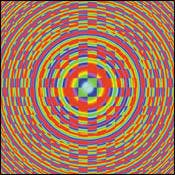Photonic transistor offers switching efficiencies
By MEGHAN FULLER
When Ralph Bennett retired from the telecommunications industry to enjoy the tranquility of his farm, he never dreamed anything could lure him back to work, but he was wrong. He learned of a startup that had developed the photonic version of the electronic transistor-some thing that companies like AT&T and IBM have been working on to no avail since the 1980s-and promptly left the tranquility of retirement behind. He now serves as president of All Optical Networks Inc. (San Diego), whose photonic transistor "switches light with light at the speed of light." Though still operating only in the laboratory, its potential impact on the marketplace, from both a technological and economic perspective, could be staggering.
Bennett describes the photonic transistor as an active element of an optical circuit that may be used as an amplifier, detector, or switch. It implements electronic analog and Boolean components in the optical domain-without the use of intermediate electronics, special crystals, nonlinear materials, or stimulated emissions. Instead, the photonic transistor employs light-frequency electromagnetic energy as a power source for the intensity gain of other electromagnetic signals.The transistor is based on a well-established principle of light known as interference, which is the product generated by the superposition of two or more independent lightwaves of the same frequency, polarization, and phase.
"Say you have two lasers, and the lights come together and combine. At the point where they superimpose one another, that's what we call the interference point," explains Bennett. "If we do that in the same frequency and phase, we get an effect called constructive interference; they combine and are additive." Destructive interference occurs when the lasers are out of phase, and they subtract from one another.
Inexpensive holograms are used to move the energy resulting from interference from one area into another area. "But we always adhere to the Conservation of Energy [Law]," says Bennett. "We do not create or destroy the energy; we merely redistribute it. We increase the power in a given area by redistributing the intensity of the light," he explains.
"The photonic transistor, then, consists of holograms that will control the light in such a way that we can use one light beam to control another one to amplify or detect a signal or even switch a signal," asserts Bennett. "We can take the outputs of those holograms and actually produce logic circuits, like ANDs, NANDs, ORs, NORs." All of these logic functions occur at femto-second or 10-15 speeds.
The folks at All Optical Networks plan to use the photonic transistor as the foundation for a device they are calling the photonic integrated circuit (PIC). By stacking holograms or interconnecting them using fiber or waveguides, they can create complex ICs that will enable them to do more logic functions in a single package. According to Bennett, existing semiconductor process equipment and CAD tools may be used to produce PICs.
All Optical Networks' transistor has the potential to profoundly impact the market, asserts Victor Valdivia, CEO of Hudson River Analytics (New York), an independent investment research provider specializing in emerging companies. "Right now, when people talk about photonic switching, those switches do some very basic things. They just switch light beams; they don't perform any logic. But these guys can perform a lot of logic, and they claim to be able to handle the basic transistor functions already," he says. "Granted, there's no product out yet, but what they claim to be producing in the lab is the basic gating operations of the transistor. People use the term 'disruptive technology,' but this really falls into that category."
Routing is one area in which the photonic transistor could have a significant impact, reducing both the complexity of the network as well as its cost. When information is transmitted over light today, that light has to be converted to electricity so the equipment can process the data rate, the destination of the packets, etc. "There's a lot of equipment being used to do those operations right now," says Valdivia. "If we can do that in light, the savings will be substantial for the carriers. There is a very big market for this and a lot of companies stand to make a lot of money exploiting this opportunity," he contends.
That's not to say the photonic transistor is a sure thing. The first challenge, asserts Valdivia, is finding a way to manufacture the photonic transistor on a commercial scale in an economical fashion. "We need to see these things not only operating in the lab; we need to see them operating commercially," he says. "So the challenge is going to be in the economics of the commercial fabrication of the photonic transistor."
Valdivia is encouraged by the company's business plan thus far, however. The company announced its MetroScout four-channel add/drop multiplexer, based on technology derived from the photonic transistor, at SuperComm in June. "They are not just pie-in-the-sky or an ivory-tower-type place with some hot technology," he says. "They're actually thinking about the market, and they're trying to enter the industry, trying to sell product to the carriers, and trying to build relationships that they will need down the line."
The company received its first patent for the technology that was to become the photonic transistor in 1994. Since then, 11 additional patents have been received and 40 are pending.

